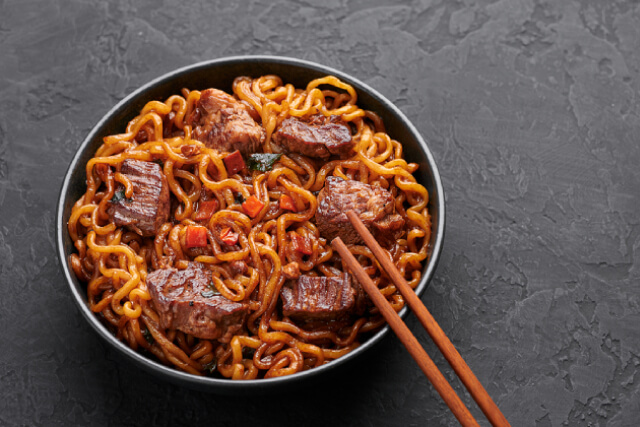Korean food has gained immense popularity amongst food fanatics and non-foodies alike, especially after the Hallyu Wave takeover and Oscar domination by the movie Parasite (2019). One of those Korean foods that have managed to take the world by storm is instant noodles – and it’s no wonder why! Not only are they packed with flavours, instant noodles are also affordable and convenient, making them an irreplaceable addition to the list of favourite go-to meals of many.
Emergence Of Korean Instant Noodles
Instant noodles rose to prominence about 60 years ago, and are used to feed the starving Japanese population once WWII had ended. In a few years, ramen culture proliferated to other countries that then spawned their own versions – and Korea was most definitely one of them.
Created in the early 1960s, ramyeon was very much a product of its time. Koreans at that time were increasingly finding themselves money-rich and time-poor as the country trailblazed its development and industrialisation. As such, they needed something that can be prepared within a short time, and when ramyeon hit the stores, it immediately filled this niche to a tee.
Ramyeon is, however, not to be confused with Japanese ramen as, apart from its difference in origin, the taste profile is very much different. As opposed to the mild and subtle flavours that marked Japanese cuisine, ramyeon is made to suit the Korean taste palate and is made with spicy broth that packs a punch.
Cooking Ramyeon Like The Locals Do
If you wish to immerse yourself in the ways Koreans love to cook their instant noodles, you’ll first want to get your hands on an aluminium pot that gives off the symbolic ‘off-gold’ colour. Also known as a ‘yangeun nembi’, this pot can heat up fairly quickly – an attribute that is important since ramyeon is supposed to be a time-saving meal.
Creativity with ramyeon is one of the reasons why it is popular and well-known. By adding different ingredients, one can effectively transform a single ramyeon dish into a better balanced and nutritious meal. The common ingredients include bean sprouts, bean paste, milk, meat and even coke!
If you’ve watched Parasite (if you haven’t, what are you waiting for?), you’ll most likely know of ram-don, otherwise known as jjapaguri. Jjapaguri is a popular food trend that features a mix of two different types of ramyeons, jjapagetti and neogurri. This recipe first originated when soldiers experimented with ramyeon recipes during their free time, and made them available on the internet. This trend only started to gain popularity when it hit mainstream television in 2013, capturing the hearts of hundreds and thousands of Koreans.
Just as how ramyeon was developed from ramen to match the Korean taste buds, its global fans also experimented with its recipes to create a fusion ramyeon recipe to fit theirs. With the versatility and creativity imbued in its recipes, ramyeon quickly transformed from being a quick fix dish, into a meal that displays an amalgamation of cultures and identities that represent not just Korea, but other countries as well.
Ramyeon: More Than Just A Meal
Even though they are known as quick and filling meals, ramyeons carry several cultural significant meanings. One of which is a cure for hangovers, also known as haejang. Koreans are known as the second-highest alcohol consumers in the world, with alcohol being part and parcel of their social and cultural norms. Ramyeon is a meal consumed either at night or the morning after, to overcome and decrease the effects of the hangover.
One other interesting development involves these Korean instant noodles becoming a pop culture in recent years. Ramyeon became a litote and turned into a symbol of seduction. Much like “Netflix and Chill” in America, “ Do you want to eat ramyeon at my place?” became a litote that became popular across all generations.
Ramyeon is Korean instant noodles, but it’s also more than that. Imbued with many cultural and historical connotations and backgrounds, this dish has made its way into every Korean’s heart, effectively becoming part of the Korean cultural DNA.
Apart from food, one other way to help you immerse in the Korean culture and tradition is to simply pick up its beautiful language! Language is the first gateway to true immersion and appreciation, so start with enrolling yourself in a Korean language course in Singapore today!


